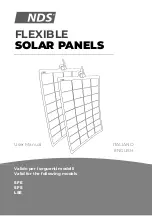
38
Installation Manual: BIPV Modules
37
Installation Manual: BIPV Modules
5�3�6 Marking the Horizontal Positions of the Mounting Clamps Profile
1. Stretch a line between the two bottom left reference points EL and bottom right ER (see Diag. “Calibration”).
2. Stretch a line between the right-hand reference point ER and the top right reference point RR (see Diag. “Calibration”).
Notice
Measuring the clamp positions from one clamp to the next will lead to measurement chain errors.
Determine the position of each Mounting Clamp Profile from the right-hand reference line (= tension line
on the right-hand edge of the PV array).
Figure 31: Mounting clamps horizontal positions
5�3�7 Laying the Bottom Row of Modules
1. On the bottom batten, mount the Mounting Clamps Profile with 2 screws each, horizontal position at the marked points,
vertical position such that the top edge of the mounting clamps is at the same height as the tension line (the mounting
clamps should NOT push away the tension line!).
Figure 32: Mounting clamps bottom row
Figure 33: Fitting the mounting gauge
3. On each batten, mark the horizontal positions of the Mounting Clamps Profile at the following positions starting from the
tension line on the right-hand edge of the PV array:
18 mm
18 mm + R
hor
18 mm + 2×R
hor
…
18 mm + N
hor
× R
hor
If you are using a mounting gauge:
2. Remove the tension line at the bottom end of the PV array and screw in the screws at positions E
L
and E
R
tightly.












































